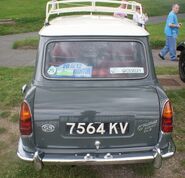
Wolseley Hornet front view
The Wolseley Hornet was a car that was related to the Mini (British Leyland) and the Riley Elf. The Riley Elf and the Wolseley Hornet were built as more luxurious Minis. The styling was the first big difference with their longer rear wings and larger boots. They also had a traditional upright grill and larger hubcaps. The Hornet was the cheaper of the two and there were 28,455 Hornets built.
Wheelbase of the Hornet remained at 2.036m, whereas the overall length was increased to 3.27m. This resulted in a dry weight of 638kg/642,3kg (rubber/hydrolastic suspension) 636,4kg for the Hornet. Front-end treatment, which incorporated each marque's traditional upright grille design (the Hornet's grille with a lit "Wolseley" badge), also contributed to a less utilitarian appearance. The cars had larger-diameter chrome hubcaps than the Austin and Morris Minis, and additional chrome accents, bumper overriders and wood-veneer dashboards.
The full-width dashboard was a differentiator between the Elf and Hornet. This better dashboard was the idea of Christopher Milner the Sales Manager for Riley. Both the Riley Elf's and Wolseley Hornet's bodies were built at Fisher & Ludlow under their "Fisholow" brandname. Plates in the engine compartment on the right side fitch plate bear evidence of this speciality. Very early Mark I versions of both cars (e.g. press photo of 445MWL) had no overriders on the bumpers and a single piece front wing (A-panel and wing in one piece, no outside seam below scuttle panel) that was soon given up again, allegedly due to cost. The Elf's and Hornet's special bumper overriders first appeared in 1962. Early production Mark Is also had a combination of leather and cloth seats (Elf R-A2S1-101 to FR2333, Hornet W-A2S1-101 to FW2105) whereas all later models had full leather seats. Mark I models were equipped with single leading shoe brakes on the car's front.
Both the Elf and the Hornet went through three versions. Initially, they used the 848 cc 34 BHP engine (engine type 8WR) with a single HS2 carburettor, changing to a single HS2 carburettor 38 BHP version of the Cooper's 998 cc power unit (engine type 9WR) in the Mark II in 1963. This increased the car's top speed from 71mph (114km/h) to 77mph (124km/h). Therefore Mark II cars also came with increased braking power in form of front drum brakes with twin leading shoes to cope with the increased power output. Both Mark I and Mark II featured 4 gear, 3 synchromesh gearboxes with rod gear change (aka "magic wand" type). Automatic gearboxes became available on the Mark II in 1965 as an option. The Mark III facelift of 1966 not only brought wind-up windows and fresh-air fascia vents: disk brakes replaced front drum brakes. Also concealed door hinges were introduced two years before these were seen on the mainstream Mini. The gear selecting mechanism was updated to the rod type as seen on all later Mini type cars. Automatic was available to the Mark III in 1967 again. Full 4 synchromesh was eventually introduced during 1968. 30,912 Riley Elfs and 28,455 Wolseley Hornets were built. Production ceased in late 1969 when British Leyland decided not to use the Riley and Wolseley brandnames anymore.
Vehicle Identification - Serial Number Prefix Letter Code: 1st prefix letter - name: R-Riley, W-Wolseley 2nd prefix letter - engine type: A 3rd prefix letter - body type: 2S - 2-door Saloon 4th prefix - series of model: 1 - 1st series, 2 - 2nd series, 3 - 3rd series 5th prefix (used to denote cars different to standard right hand drive): L - left hand drive Code example: R-A2S1-154321 (Riley, A type engine, 2 door saloon, 1st series, serial number "154321")











